Get acquainted with SS Cygni, the sky's brightest cataclysmic variable star. It's guaranteed to keep you on your toes.
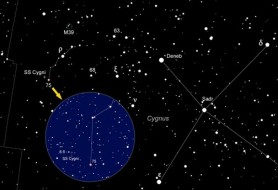
Bob King / Source: Chris Marriott's SkyMap
I got hooked on variable stars in the '80s when I bought a new, expensive telescope and promised myself I'd "do some science" with the thing instead of just poking around the sky. Not that there's anything wrong with poking around the sky.
I soon joined the American Association of Variable Star Observers (AAVSO) and discovered I was drawn to stars with wild, unpredictable swings in brightness. So-called cataclysmic variable stars soon became my focus and one in particular, SS Cygni, an all-time favorite.
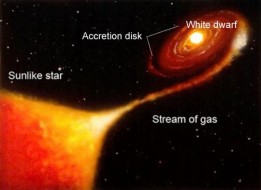
NASA
Cataclysmics, also known as dwarf novae, are binary stars in close orbit about one another. One of them is Sun-like, the other a compact white dwarf star with an appetite. Their embrace is so tight — 100,000 miles for SS Cygni according to some estimates — that the dwarf's powerful gravity strips material from its companion and feeds it into a spinning whirlpool of glowing hydrogen gas called an accretion disk.
Changes in the rate of flow of material into the disk can cause it to suddenly burn much hotter and brighter. Not only does the disk radiate more light, but it can heat the surface of the companion star, causing it to glow more brightly, too.
Some dwarf novae such as U Geminorum can jump from magnitude 15 to 9.5 in just 1-2 days. After an outburst, the star slowly returns to its original quiet state and then flares up again weeks or months later.
SS Cygni's two stars whirl like stellar Tilt-A-Whirls around their center of gravity once every 6.5 hours. Most nights, the system simmers away at magnitude 12, but during an outburst its light increases 40-fold to about magnitude 8, bright enough to spot in 50-mm binoculars! In the same way we're drawn to the beautiful symmetry of Orion's Belt stars, many of us are captivated by SS Cygni's striking and unpredictable moods.
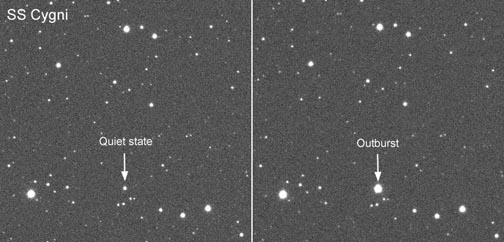
Bob Modic
After all, it has everything going for it. This temperamental star is bright enough to follow in a from minimum to maximum in a scope as small as 4.5 inches, it's relatively easy to find, and it undergoes an outburst every 4 to 10 weeks with a duration of a week or more.
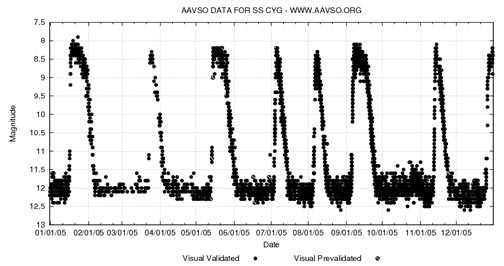
AAVSO
Seeing SS Cygni in outburst after several weeks of quiescence makes for a delicious thrill. It's as if the star has been transformed from a lump of coal into a diamond. And to think you're witnessing this vampire-like interaction between two distant stars from your own front yard.
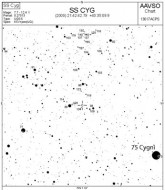
AAVSO
You don't need ideal skies or even good seeing. Heck, it can be mostly cloudy. Variables aren't picky. I've popped the scope out to catch my favorites between cloud banks. I make a quick brightness estimate for the AAVSO using one of their free, online charts, note the time and get in before the rain starts falling.
Of course you can observe for fun and not worry about making brightness estimates, but if you'd ever like to contribute a bit to our scientific understanding of the inner workings of cataclysmic variables, the AAVSO welcomes your observations.
Last year, amateur astronomers' careful monitoring of SS Cygni's brightness proved crucial in helping an international team of radio astronomers finally determine an accurate distance (372 light-years) to the star.
The previous estimate of 520 light-years made with the Hubble Space Telescope didn't jibe with our understanding of the brightness of accretion disks. The new distance resolves the issue while showing how amateurs can make a difference.
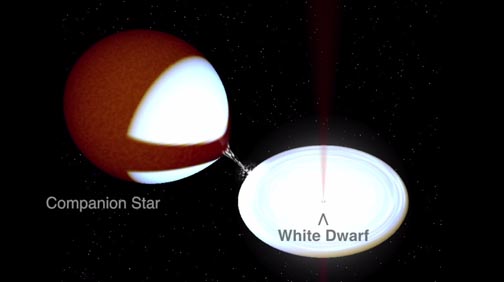
J. Miller-Jones (ICRAR), using software created by R. Hynes
As I write this, SS Cygni only days ago underwent a brief outburst to magnitude 8.4. It's since dropped to the mid-nines as it returns to quiescence. Or will it? That's what makes this star so fun — it's predictable to a degree but doesn't always perform as expected.
To find our featured star, start with Deneb at the head of the Northern Cross. About 10° to star's east (and 3° south of the bright, loose open cluster M39), stop at the 4th-magnitude star Rho Cygni. Follow the zigzag of stars below Rho some 3° south to 5th-magnitude, red-hued 75 Cygni. You'll find SS Cygni less than 1/2° to the northwest at the south end of a triangle of 9th-magnitude stars. Once there, the AAVSO chart above will help you estimate its brightness.
Find a comprehensive and handy list of double stars in Sissy Haas's catalog Double Stars for Small Telescopes.
 2
2









Comments
Anthony Barreiro
September 10, 2014 at 6:46 pm
Thanks Bob. A direct link to a printable black-on-white chart would have been convenient. I went to the AAVSO chart link, entered the chart number from the pop-up window in this article, fiddled around with it, and printed out a chart, but it took a few minutes.
You must be logged in to post a comment.
thomas worthen
September 12, 2014 at 5:12 pm
bob
for us tyros who want to use the AAVISO chart
ss cyg oe
HD 206697
You must be logged in to post a comment.
You must be logged in to post a comment.